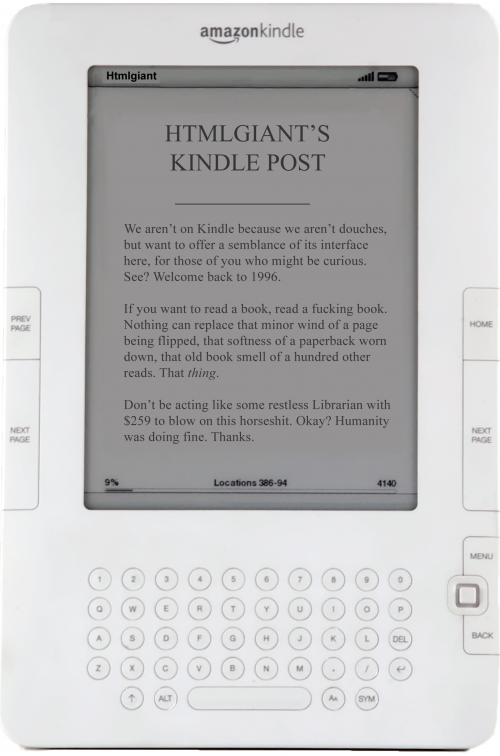SarcMark, it’s awesome

Sarcasm, Inc. has patented a “SarcMark,” a punctuation mark which looks like a recoiled question mark, to signify sarcasm. Of their 3rd “Core Belief,” they proclaim “For centuries, questions and exclamations have had their own punctuation marks. It’s time that sarcasm is treated equally!” Wow, that’s pretty cool how they used that antiquated exclamation mark![]() . Yah, these guys are not only cutting-edge grammarians, but great entrepreneurs
. Yah, these guys are not only cutting-edge grammarians, but great entrepreneurs![]() .
.
Isn’t it funny how this sentence raises a question without a question mark. Or how “the decapitated man still flinched” is arguably more effective than “the decapitated man still flinched!” Intent, when implicit, is a sharper, smoother cut. The author’s story lies not on the page, but in the reader’s mind.
Christ, I just wish I could download the SarcMark, because without it, without that fucking awesome SarcMark I cannot be sarcastic! I can only be excited — with or without any marks signifying those feelings — so, so excited.
On Earth As It Is
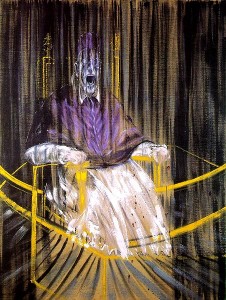 I don’t know if someone else was going to write about this here at htmlgiant, and they still oughta if they wanna, but in the meantime let me say: everyone tune your browser to On Earth As It Is, a new web journal that uses prayer as a story telling form. As the website puts it, “On Earth As It Is is a cycle of prayer narratives, or dramatic monologues addressed to God, from writers of different faiths.” It’s run by our beloved Matthew Simmons and Bryan Furuness, and so far they’ve run two pieces (one per week). Last week we were given an Augustinian-but-more-lovely apologia from Melanie Rae Thon:
I don’t know if someone else was going to write about this here at htmlgiant, and they still oughta if they wanna, but in the meantime let me say: everyone tune your browser to On Earth As It Is, a new web journal that uses prayer as a story telling form. As the website puts it, “On Earth As It Is is a cycle of prayer narratives, or dramatic monologues addressed to God, from writers of different faiths.” It’s run by our beloved Matthew Simmons and Bryan Furuness, and so far they’ve run two pieces (one per week). Last week we were given an Augustinian-but-more-lovely apologia from Melanie Rae Thon:
What more evidence do you need?
Snow melts into dark earth and here in damp woods white trillium blossoms.
and yesterday, from Erin McGraw, “A Statement from the Defense.” READ MORE >
March 19th, 2010 / 9:56 am
We’ve been linked at The New Yorker, thanks to either Lucy Tang, Brandon Scott Gorrell, Tao Lin, or you +200 emotional people.
Big hat tip to Elliott David for passing this along to me.
httpv://www.youtube.com/watch?v=Weq_sHxghcg&
A Very Long—and Very Interesting—Interview with Matthew Stadler of Publication Studio
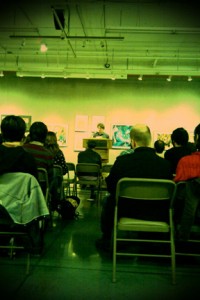
Matthew Stadler reading from his new Publication Studio published novel at Smallpressapalooza at Powell's Books.
Spotlit recently on Dennis Cooper’s blog, Portland’s Publication Studio—brainchild of novelist Matthew Stadler and his business partner Patricia No. Using print on demand equipment, PS puts out books by a number of innovative writers—including two of my favorite Seattle authors, Stacey Levine and Matt Briggs—rescues the out of print or in publication limbo, and generally advocates for a more nimble, more author-centric publishing world. I asked Matthew some questions. Matthew answered.
I wanted to know more about the machine you are using to bind the books. Could you tell me about it? Where you found it? Who had it before you? What it was used for?
Yes, we use two machines. The one that got us started, that we call Ol’ Gluey, is the heart of an old Instabook III system that was developed by a man named Victor Celario, a Mexican who started the business in Morelia and Mexico City and expanded it when he moved to Florida. Victor calls Instabook “the Mr. Coffee of portable print-on-demand.” Victor designed and patented his integrated POD system in the late 1990s, aiming for a market of self-publishing authors, the people who now use Lulu or Apple’s iBook or Blurb. The Instabook rig that we have started out at a bookshop in NewJersey in the late 1990s, performing that service (as far as I know) and then migrated to Brooklyn’s Longdash Printing, which became a printing arm of a local cafe called VoxPop. Gabriel Stuart used it there to publish more would-be self-publishers and he might have tried publishing an imprint, I’m not sure. Gabe wanted to change the focus at VoxPop and had been trying to get rid of the Instabook for a year or two when I saw his blogpost offering it at a cheap price. I flew to NYC with my ten-year old, rented a van, and drove it back to Portland last summer. We got a Kyocera FS9130DN duplex B/W printer, Ol Gluey, and an Ideal guillotine trimmer from Gabe (all parts of the Instabook III system) and started to make books in September 2009. Since then we have added a Chinese knock-off of a perfect binder, a rig you can get online for $700 – $900. We do about half the books on that and half on Ol’ Gluey. READ MORE >
Poker as Storytelling: Affect, Trickery, Common Sound
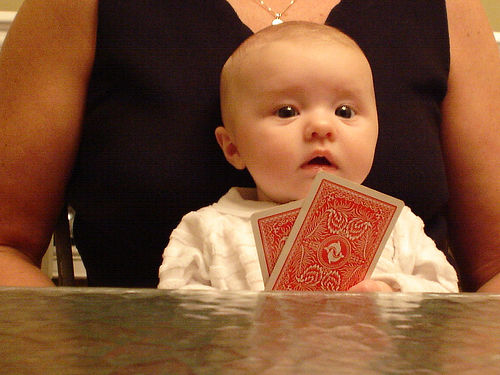
Many poker players will tell you that every hand is a story. In hold em, the four rounds of betting, the exposed community cards (given to the table in a set of three, then one more, then one more), and your two hole cards, are simply a skeletonic structure around which your action (the bet, the posture, the air around the table, speech, eyes) often are the body of what occurs. Many hands of poker fail to develop into powerful hands (i.e. both players have something but often not the nuts), thus the money frequently tends toward the player that can best present himself in a light that makes him seem provocative, working, putting fear in the other player. It becomes a question of who can tell the most believable story: if I believe that you have me crushed, and I acquiesce, it does not matter what you actually have.
The best poker players in the world, then, aren’t those who catch the most cards (as over time fate levels all), but those who are the most effective in masking their weakness, and exposing the weakness of the other. One of the biggest mistakes a neophyte makes when bluffing is failing to make their bluff make sense: they simply push hard, thinking that it is sheer aggression, and not calculated stories, images, that win pots. A common basic tactic of bluffing against a hand that had been strong early in the story is to bet “scare cards,” such as cards that complete a flush or straight draw, or betting an ace on the river when the high card had been a queen before. Betting as if the scare card completed your drawing hand, whether it does or not, can be enough to make weaker player fold. When scare cards don’t come, late bluffing is more easily picked off, as it is harder to give a player credit for a hand.
At higher levels, though, players are more aware of the tactics of storytelling. They are also aware that you are aware of them being aware, so the levels of who is representing what when and what do they think you think are constantly in flux, making high level poker play sometimes as exciting on a visceral level as writing that takes risks (both making it, and consuming it). There is a mash up of gut instinct, rational odds, emotional texture, board texture, physical surroundings (what do the opponent’s shoulders tell you about his or her hand? what do his or her eyes? how the chips are moved? the breathing. etc., not to mention the retro-image of what each player did three hours ago, three months ago, three years, up to right now), together create a continuity of immediate and retroactive value which in sum creates an environment to be processed, reacted to, explored, and yet is as cut and dry on the base level as a sentence printed on a page. Great players can seem as if they know exactly what you are holding in the midst of a hand. The greatest players go even beyond that, as if they not only see your hand, but now will draw you down another leg of the story, cause affect to you, do you some kind of rupture. Certain kinds of play, beyond money, can affect your spirit, your persona. A great session of poker, like an exceptionally great text, can make or break your month or year.
Bookstore Interview: Normal’s Books & Records, Baltimore
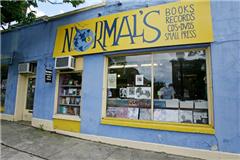 Google “Baltimore used bookstore” and click “I’m feeling lucky.” You will be. The first hit is Normal’s Books & Records, one of the best used shops I’ve ever been to. It isn’t just the selection that makes it great, though it’s clear that Rupert Wondolowski, who runs the buying there, knows great literature beyond the classics. It isn’t just the personality of the store, even though there are plenty of funny signs and doodads around to keep your friends interested while you spend an hour searching for some lost dub record. What I like best about Normal’s is: dang, they are invested in the local arts scene. Aside from stocking all the amazing books, music, zines etc. that get put out around town, the collective hosts weekly shows at the Red Room, which is attached to the store, Rupert runs an always-interesting reading/performance series called “Shattered Wig Night” and he also puts out an old-school tape-up journal called The Shattered Wig Review. Oh yeah, and he wrote a pretty dynamite book called The Origin of Paranoia as a Heated Mole Suit (Publishing Genius 2008). Interview about bookselling after the break. READ MORE >
Google “Baltimore used bookstore” and click “I’m feeling lucky.” You will be. The first hit is Normal’s Books & Records, one of the best used shops I’ve ever been to. It isn’t just the selection that makes it great, though it’s clear that Rupert Wondolowski, who runs the buying there, knows great literature beyond the classics. It isn’t just the personality of the store, even though there are plenty of funny signs and doodads around to keep your friends interested while you spend an hour searching for some lost dub record. What I like best about Normal’s is: dang, they are invested in the local arts scene. Aside from stocking all the amazing books, music, zines etc. that get put out around town, the collective hosts weekly shows at the Red Room, which is attached to the store, Rupert runs an always-interesting reading/performance series called “Shattered Wig Night” and he also puts out an old-school tape-up journal called The Shattered Wig Review. Oh yeah, and he wrote a pretty dynamite book called The Origin of Paranoia as a Heated Mole Suit (Publishing Genius 2008). Interview about bookselling after the break. READ MORE >
Massive Hangover, Massive Roundup
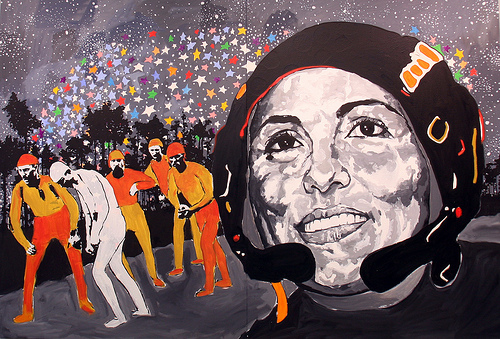
Okay, I’m being a little dramatic, but seriously, Michael–a Long Island iced tea to end the night with? You’re an animal. My kind of animal. ANYway.
The Rumpus has an interview with the artist Jake Gillespie (worksample above), whom we in Poetryland know as “the guy who did that cool cover (and interior) art for Mathias Svalina’s Destruction Myth.”
The Second Pass celebrated their 1-year anniversary recently (hey, cheers!) and they mark the occasion by taking a break from the newer-newer-now pace of publishing/culture to take a look at some very untimely (and in some cases, unavailable) books. “Tales of the Unread.” I was especially intrigued by Jacob Silverman’s discussion of Past Continuous, a 1977 novel by the Israeli author Yaakov Shabtai, and Matt Weiland’s discussion of Killings by Calvin Trillin, a 1984 true-crime book from more or less the last person on earth you’d ever expect to produce a true-crime book.
Speaking of things you’ve never heard of. Over at The Daily Beast, Elif Batuman introduces the Tolstoy-weary Russo-phile to four “alternative Russian classics” by Shklovsky, Platanov, Mandelstam, and Kharms.
No One Would Ever Say That
[Much thanks this morning to Elisa Gabbert, who sends thoughts on plainspokenness. – BB]
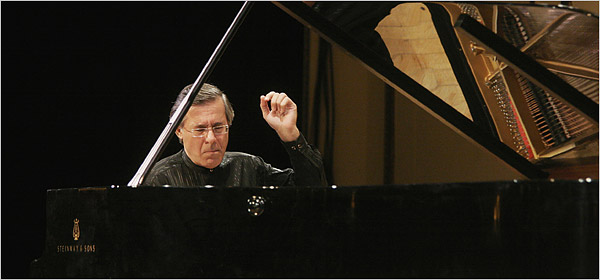
Over at the new Ploughshares blog (I wrote for it back when it was a humble blogspot), Peter B. Hyland is talking about accessibility and the closely related (in poetry at least) matter of “plainspokenness,” as “plainspoken” poets (such as Billy Collins, he offers) are less intimidating and considered “more convivial.”
It’s a familiar idea that poetry should sound like speech. But Hyland doesn’t claim this; instead, he suggests that “maybe there’s no such thing as plainspoken poetry,” using “The Red Wheelbarrow” as an example of a seemingly plainspoken poem that doesn’t really sound like how people talk.
This reminded me of a post I read years ago (in 2007) on Jonathan Mayhew’s blog:
I learned something quite significant from this. I learned that C Dale Young and I do not speak the same language, poetically speaking. I searched through a recent poetic sequence of mine, The Thelonious Monk Fake Book, to see whether I use words like dark, sadness, chest, hands, water, rain, body, silence. Generally, I don’t use these words very much if at all. Where my vocabulary coincided the most with his was in an Ira Gershwin lyric I happened to be quoting at one point. “Holding hands at midnight , ‘neath the moonlit sky.” I did use “blue” a lot, but that was quoting the titles of Monk tunes, mostly.
It’s no criticism of C Dale’s excellent book of poetry of course to say that I simply couldn’t bring myself use words like that (very much). To me they are *poetry words.* In other words they might correspond to what the average person expects to find in a poem. I don’t like depending on an identifiably poetic tone. On the other hand I’m sure my own *poetry words* would be just as embarrassing, if I knew what they were… If I did know I’m sure I would be obliged to ban them, viewing them as crutches that I was better off without…

